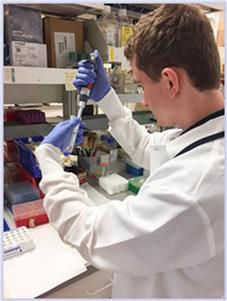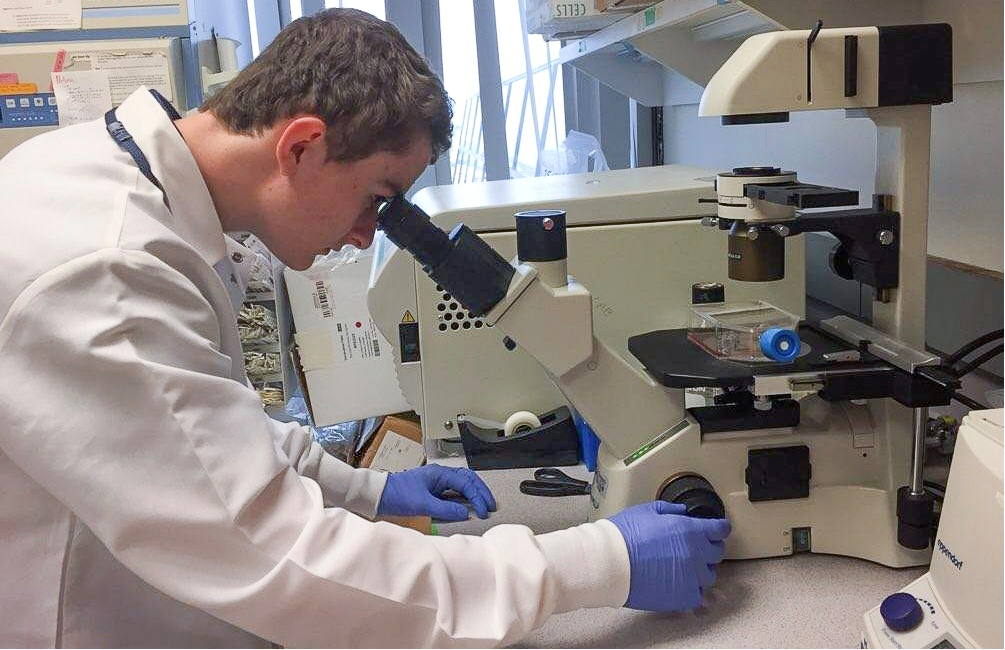
I turned 18 this summer but there was a time when my parents questioned if I would ever reach adulthood. When I reflect on my experience as a brain tumor survivor, there’s no escaping the difficult years of chemotherapy treatments, surgeries, and time spent at Children’s National Medical Center. However, through those difficult times, I’ve discovered talents and opportunities that may not have otherwise been revealed to me. My experience as a cancer patient has changed the trajectory of my life in challenging yet amazing ways.
The Childhood Brain Tumor Foundation has been a constant presence since my family turned to them for support within months of my optic nerve glioma diagnosis. Ms. Young provided my parents with medical information, vision impairment resources and emotional support. I have grown up being involved with CBTF as a cancer survivor and more recently as a volunteer. I am honored to serve as student ambassador and happy to share my story, especially some uniquely positive aspects of my journey.
When I was diagnosed, I did not have any of the typical brain tumor symptoms such as headaches or seizures. My parents noticed that one of my eyes seemed to be protruding more than the other. As a precaution, they took me to an ophthalmologist who observed that my optic nerves had an unhealthy color. He made a phone call and later that afternoon I was having a CAT scan at the hospital. We learned that I had optic nerve glioma that day with hand motion only vision in my left eye and some impairment in my right eye. After surgery to implant a broviac catheter, I began my first chemotherapy regimen of carboplatin and vincristine. During this time, I had MRIs every three months and a craniotomy to drain a cyst near the optic nerve of my good eye. The treatments worked, and after a year and a half my tumors were reduced drastically in size. My catheter was removed, and I enjoyed a brief period off treatment.
Follow-up MRI scans about a year later revealed tumor enhancement and growth. I had surgery to implant a port-a-cath and began my second chemotherapy regimen of carboplatin and vincristine. It worked well again and stopped the tumors from progressing. I had my catheter removed and was monitored every three months through neuro-oncology visits and MRI scans. Unfortunately, these scans showed renewed tumor activity after a short time. I started an oral chemo medication called Temodar. The good news was that my mom could give the pills to me at home. The bad news was that I couldn’t swallow pills, so she mixed them into applesauce that tasted terrible. The third chemotherapy regimen was the charm and I have been off treatment for many years. We celebrated every milestone as I moved from MRI scans every three months to six months to currently once a year.
There was considerable downtime at the hospital during treatments and at home when I was immuno-suppressed, so my family played a lot of games. I discovered a passion for strategic board games. Not only did I enjoy playing them, but I was really good for my age and could often beat my dad. I developed a special affinity for chess. The board and pieces were high contrast and easy to see despite my vision impairment. I also liked how each game was different from the next with endless possibilities. I started attending the youth program at the U.S. Chess Center and joined my elementary school chess club. I competed in local tournaments and progressed to state and national events. I won the Virginia scholastic championship in 3rd grade and have placed in the top ten at state and national scholastic tournaments for several years. I achieved Expert title last month with a 2000+ rating and am already working on my next goal to become Master. I often wonder if I would have discovered chess if it hadn’t been for my cancer diagnosis and treatment.

In 2017, I saw an opportunity to combine my love of chess with giving back to an organization that has done so much for me. My friends are founders of Chess4Charity, a nonprofit that raises money for charities through a semi-annual chess tournament. As an elementary and middle school student, I had participated in these tournaments as a player and volunteer. I partnered with them to designate CBTF as beneficiary of their 2017 tournament that raised nearly $8,000. Mr. and Mrs. Young attended the event and spoke to participants about CBTF’s mission. It was gratifying to be able to promote cancer research through chess.
My experience as a cancer survivor has also presented me with unique summer opportunities. I participated in the FDA’s Summer Scholars Program with their Oncology Center of Excellence in 2017. I learned about the world of cancer drug development from many perspectives including the research, clinical, regulatory, policy, and commercial aspects of development, through site tours and lectures. Interning at the FDA showed me that there are many ways to get involved in cancer research, not only as a scientist but as a businessperson. As a cancer survivor, I contributed my first-hand knowledge of the experience of cancer patients, culminating in a presentation on my last day. In this way, I provided the other interns and FDA employees with a more complete understanding of what it means to have cancer.

I enjoyed my time at the FDA and was eager to apply this knowledge to hands-on cancer research. I am doing exactly that this summer at the Center for Cancer and Immunology Research at Children’s National Medical Center. Dr. Brian Rood has been my oncologist for over a decade and knows me well. When he learned of my computer science skills, he offered me the opportunity to work with his team on bioinformatics research. I have many responsibilities as an intern including running GATK (Genome Analysis Toolkit) workflows needed to search medulloblastoma whole-genome-sequence reads for DNA mutations and log them in databases. These mutations have the potential to create unique tumor specific proteins which we can find using the databases I create, and the output of a machine called a mass spectrometer which analyzes proteins. While my end goal for each tumor sample is to arrive at a functional database, I’m also mindful of the amount of time and user input required to run each sample. To that end, I strive to make the workflow as efficient as possible by using GATK’s WDL tool, which parallelizes the workflow tasks. With WDL, I made the Mutect2 phase of analysis about six times faster while maintaining the same level of accuracy. Similarly, I’m also rewriting old scripts to be more adaptable when we move on to analyze new samples.
After interning for a few weeks, Dr. Huizhen Zhang asked if I would like to assist her in her lab work. I was thrilled to have the opportunity to take on a new challenge. She tasked me with “splitting” or sub-culturing cells, taking one flask of medulloblastoma cells and transferring them to new flasks so that they could keep growing. I used a 1:3 split ratio, meaning that the cell volume was split equally from one flask to three. I also had to add a Trypsin and EDTA solution to each flask, which prevents the cells from sticking to each other and to the flask. The entire process was very precise. I used extreme caution at every step to ensure that the cells remained sterile. I even had to look at the cells through a microscope to ensure that they were floating and not clumped together.
At the end of July, Dr. Zhang informed me that the cells I had cultured were healthy. She invited me to come back and perform PCR. I then used a gel to amplify specific sequences in the cell’s DNA. At that point, the sample I had worked with was almost ready for a complete sequencing. The sequencing data gathered would then be passed on to me to analyze using the GATK workflow. I was amazed at how involved the entire process is and excited to participate in it from start to finish (from culturing cells to a protein database).
I would like to thank Dr. Brian Rood, Dr. Samuel Rivero-Hinojosa, and Dr. Huizhen Zhang for the opportunity to work by their side this summer. The guidance and independence they have given me has allowed me to make a personal contribution to cancer research. It has been a unique experience to go full circle from patient to researcher, one that has reinforced my commitment to cancer research advocacy in the future.
by Camden Wiseman
2018
